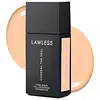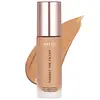Lawless Conseal The Deal Long-Wear Full-Coverage Foundation Versus Lawless Forget The Filler Skin-Plumping Line-Smoothing Foundation
What's inside
What's inside
 Key Ingredients
Key Ingredients

 Benefits
Benefits

 Concerns
Concerns

 Ingredients Side-by-side
Ingredients Side-by-side

Water
Skin ConditioningIsododecane
EmollientC9-12 Alkane
SolventSilica
AbrasivePentylene Glycol
Skin ConditioningPolyglyceryl-6 Polyhydroxystearate
EmulsifyingPolyglyceryl-6 Polyricinoleate
EmulsifyingPropanediol
SolventMagnesium Sulfate
Zinc Stearate
Cosmetic Colorant1,2-Hexanediol
Skin ConditioningCetyl Alcohol
EmollientHydrogenated Lecithin
EmulsifyingCoco-Caprylate/Caprate
EmollientPolyglycerin-6
HumectantDisteardimonium Hectorite
StabilisingCaprylhydroxamic Acid
Bisabolol
MaskingTropaeolum Majus Flower/Leaf/Stem Extract
Skin ConditioningHelianthus Annuus Seed Oil
EmollientPropylene Carbonate
SolventLycium Barbarum Seed Oil
Skin ConditioningStearic Acid
CleansingCaprylyl Glycol
EmollientZingiber Officinale Root Extract
MaskingTocopherol
AntioxidantAscorbyl Palmitate
AntioxidantCI 77891
Cosmetic ColorantCI 77492
Cosmetic ColorantCI 77491
Cosmetic ColorantCI 77499
Cosmetic ColorantWater, Isododecane, C9-12 Alkane, Silica, Pentylene Glycol, Polyglyceryl-6 Polyhydroxystearate, Polyglyceryl-6 Polyricinoleate, Propanediol, Magnesium Sulfate, Zinc Stearate, 1,2-Hexanediol, Cetyl Alcohol, Hydrogenated Lecithin, Coco-Caprylate/Caprate, Polyglycerin-6, Disteardimonium Hectorite, Caprylhydroxamic Acid, Bisabolol, Tropaeolum Majus Flower/Leaf/Stem Extract, Helianthus Annuus Seed Oil, Propylene Carbonate, Lycium Barbarum Seed Oil, Stearic Acid, Caprylyl Glycol, Zingiber Officinale Root Extract, Tocopherol, Ascorbyl Palmitate, CI 77891, CI 77492, CI 77491, CI 77499
Water
Skin ConditioningDimethicone
EmollientGlycerin
HumectantCaprylic/Capric Triglyceride
MaskingLauryl Dimethicone
Skin ConditioningTrimethylsiloxysilicate
EmollientSilica
AbrasiveMethyl Trimethicone
Skin ConditioningHydrolyzed Yeast Extract
Skin ConditioningC13-15 Alkane
SolventDimethicone/Vinyl Dimethicone Crosspolymer
Skin ConditioningSd Alcohol 40-B
AstringentSorbitan Isostearate
EmulsifyingAluminum/Magnesium Hydroxide Stearate
Emulsion StabilisingCaprylyl Dimethicone Ethoxy Glucoside
EmulsifyingSodium Chloride
MaskingSorbitan Caprylate
EmulsifyingTriethoxycaprylylsilane
Potassium Sorbate
PreservativeSodium Benzoate
MaskingSodium Dehydroacetate
PreservativeEthylhexylglycerin
Skin ConditioningDisteardimonium Hectorite
StabilisingTocopheryl Acetate
AntioxidantAlumina
AbrasivePropylene Carbonate
SolventCetyl Hydroxyethylcellulose
Emulsion StabilisingPhytic Acid
Polyglucuronic Acid
Skin ConditioningLecithin
EmollientTocopherol
AntioxidantTitanium Dioxide
Cosmetic ColorantCI 77491
Cosmetic ColorantCI 77492
Cosmetic ColorantCI 77499
Cosmetic ColorantWater, Dimethicone, Glycerin, Caprylic/Capric Triglyceride, Lauryl Dimethicone, Trimethylsiloxysilicate, Silica, Methyl Trimethicone, Hydrolyzed Yeast Extract, C13-15 Alkane, Dimethicone/Vinyl Dimethicone Crosspolymer, Sd Alcohol 40-B, Sorbitan Isostearate, Aluminum/Magnesium Hydroxide Stearate, Caprylyl Dimethicone Ethoxy Glucoside, Sodium Chloride, Sorbitan Caprylate, Triethoxycaprylylsilane, Potassium Sorbate, Sodium Benzoate, Sodium Dehydroacetate, Ethylhexylglycerin, Disteardimonium Hectorite, Tocopheryl Acetate, Alumina, Propylene Carbonate, Cetyl Hydroxyethylcellulose, Phytic Acid, Polyglucuronic Acid, Lecithin, Tocopherol, Titanium Dioxide, CI 77491, CI 77492, CI 77499
Ingredients Explained
These ingredients are found in both products.
Ingredients higher up in an ingredient list are typically present in a larger amount.
Ci 77491 is also hydrated iron III oxide. It's sole purpose is to give a red/pink hue to products.
Iron III oxides are classified as inorganic chemicals for coloring.
Synthetically created Ci 77491 is considered safer than those naturally found. This is because the synthetically created version may contain less impurities. Iron oxides are generally non-toxic and non-allergenic.
Learn more about CI 77491Ci 77492 is also hydrated iron III oxide. It's sole purpose is to give a yellow hue to products.
Iron III oxides are classified as inorganic chemicals for coloring.
Synthetically created Ci 77492 is considered safer than those naturally found. This is because the synthetically created version may contain less impurities. Iron oxides are generally non-toxic and non-allergenic.
Learn more about CI 77492Ci 77499 is also hydrated iron III oxide. It is created from mixing red and black iron oxides. This helps give shades of darkness to a product.
Iron III oxides are classified as inorganic chemicals for coloring.
Disteardimonium Hectorite comes from the clay mineral named hectorite. It is used to add thickness to a product.
It can also help stabilize a product by helping to disperse other ingredients.
Hectorite is a rare, white clay mineral.
Learn more about Disteardimonium HectoriteThis ingredient is a solvent. It helps dissolve active ingredients and alter the texture of products.
Propylene Carbonate is commonly used in makeup and with clay, such as montmorillonite or bentonite.
Studies show this ingredient to be safe for cosmetics. When it is undiluted, it can cause skin irritation. (It is always diluted in skincare and makeup). This ingredient is water-soluble.
Propylene Carbonate is created from propylene glycol and carbonic acid.
Learn more about Propylene CarbonateSilica, also known as silicon dioxide, is a naturally occurring mineral. It is used as a fine, spherical, and porous powder in cosmetics.
Though it has exfoliant properties, the function of silica varies depending on the product.
The unique structure of silica enhances the spreadability and adds smoothness, making it a great texture enhancer.
It is also used as an active carrier, emulsifier, and mattifier due to its ability to absorb excess oil.
In some products, tiny microneedles called spicules are made from silica or hydrolyzed sponge. When you rub them in, they lightly polish away dead skin layers and enhance the penetration of active ingredients.
Learn more about SilicaTocopherol (also known as Vitamin E) is a common antioxidant used to help protect the skin from free-radicals and strengthen the skin barrier. It's also fat soluble - this means our skin is great at absorbing it.
Vitamin E also helps keep your natural skin lipids healthy. Your lipid skin barrier naturally consists of lipids, ceramides, and fatty acids. Vitamin E offers extra protection for your skin’s lipid barrier, keeping your skin healthy and nourished.
Another benefit is a bit of UV protection. Vitamin E helps reduce the damage caused by UVB rays. (It should not replace your sunscreen). Combining it with Vitamin C can decrease sunburned cells and hyperpigmentation after UV exposure.
You might have noticed Vitamin E + C often paired together. This is because it is great at stabilizing Vitamin C. Using the two together helps increase the effectiveness of both ingredients.
There are often claims that Vitamin E can reduce/prevent scarring, but these claims haven't been confirmed by scientific research.
Learn more about TocopherolWater. It's the most common cosmetic ingredient of all. You'll usually see it at the top of ingredient lists, meaning that it makes up the largest part of the product.
So why is it so popular? Water most often acts as a solvent - this means that it helps dissolve other ingredients into the formulation.
You'll also recognize water as that liquid we all need to stay alive. If you see this, drink a glass of water. Stay hydrated!
Learn more about Water